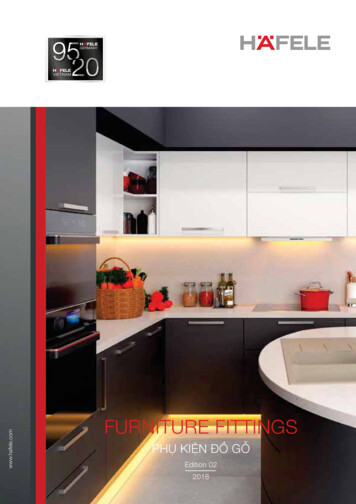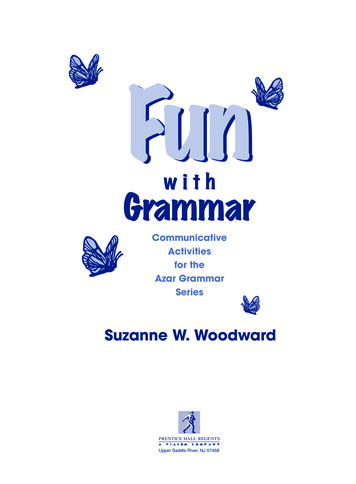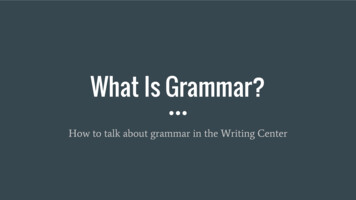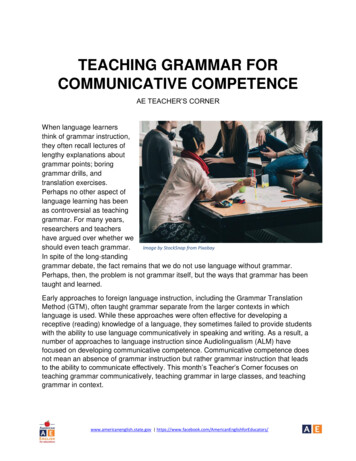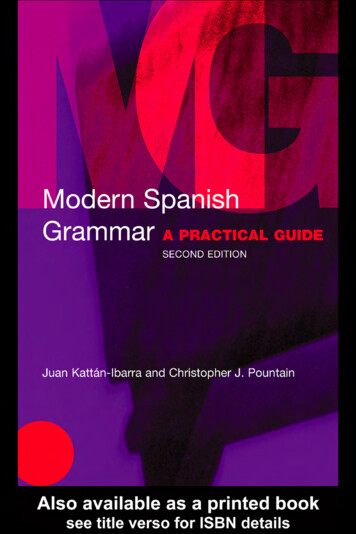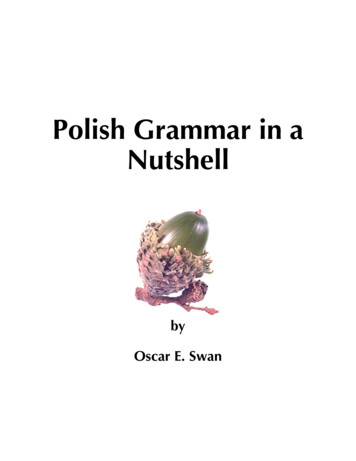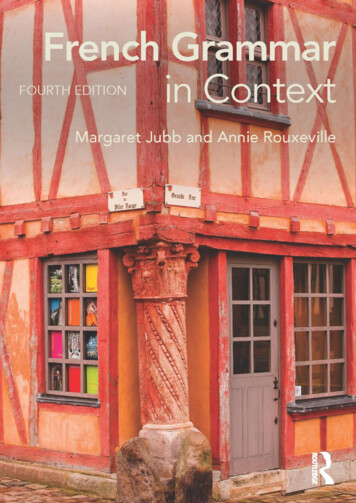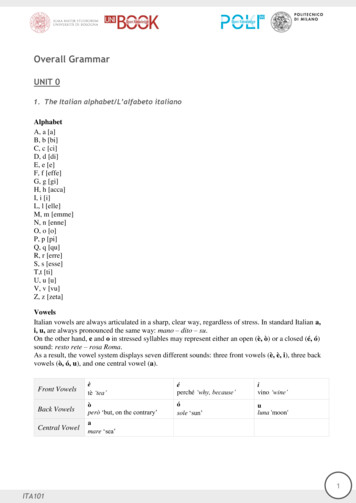
Transcription
Overall GrammarUNIT 01. The Italian alphabet/L’alfabeto italianoAlphabetA, a [a]B, b [bi]C, c [ci]D, d [di]E, e [e]F, f [effe]G, g [gi]H, h [acca]I, i [i]L, l [elle]M, m [emme]N, n [enne]O, o [o]P, p [pi]Q, q [qu]R, r [erre]S, s [esse]T,t [ti]U, u [u]V, v [vu]Z, z [zeta]VowelsItalian vowels are always articulated in a sharp, clear way, regardless of stress. In standard Italian a,i, u, are always pronounced the same way: mano – dito – su.On the other hand, e and o in stressed syllables may represent either an open (è, ò) or a closed (é, ó)sound: resto rete – rosa Roma.As a result, the vowel system displays seven different sounds: three front vowels (è, è, i), three backvowels (ò, ó, u), and one central vowel (a).Front Vowelsètè ‘tea’éperché ‘why, because’ivino ‘wine’Back Vowelsòperò ‘but, on the contrary’ósole ‘sun’uluna 'moon'Central Vowelamare ‘sea’1ITA101
Please note that writing the accent is mandatory only on the last syllable, and just on somemonosyllables, mostly with the function of disambiguating words pronounced in the same way buthaving different meanings:tè – tea/ te - youlà – there/ la - theConsonantsItalian consonants may be either short or long. Long sounds occur only in word-internal positions,and are written with double letters.b banana, rubare, sabbiac cane, muco, mucca; cena, pace, accendered domani, dado, addiof fico, gufo, ufficiog gatto, legare, leggo; giro, agire, raggil luna, pala, pallam mela, remo, mamman nove, nono, nonnop pera, sapere, tappoq quando, acquar rosa, caro, carros sera, casa, rossot tempo, note, nottev vino, nuovo, ovvioz zero, azzurro2. The Italian sounds/I suoni dell’italianoPlease note that the letter q is only found in combination with the vowel u; qu sounds like cu, and inword-internal position it is normally doubled like this: cqu.The letter h is never pronounced, but it is used to distinguish similar words (e.g. a ‘to’ vs. ha ‘he/shehas’; anno ‘year’ vs. hanno ‘they have’), and to represent different sounds for the letters c and g.C and g always sound ‘hard’ before back and central vowels (co, go; cu, gu; ca, ga), and ‘soft’ beforefront vowels (ce, ci and ge, gi), unless they are followed by the letter h (che, ghe and chi, ghi): in thiscase they are pronounced ‘hard’.SOUNDSFront VowelsBack VowelsCentral Vowelsoftce, gecio, giocia, giasoftci, giciu, giuhardche, gheco, goca, gahardchi, ghicu, gucera, amici, amiche, fichigelato, giro, streghe, maghiciò, ciurma, cosa, curiositàgiostra, giù, gola, gufo2ITA101
ciabatta, casagiallo, galloThe letters s and z may correspond to either voiced or voiceless sounds, often according to thecontext.Followed by voiced consonants (i.e. b, d, g, m, n, v, l, r), or between vowels, the letter s representsa voiced sound:sbaglio, rosawhereas at the beginning/end of words, or followed by voiceless consonants (i.e. p, t, c/q, f) it isvoiceless:sera, lapis, scuolaThe letter z tends to be voiced when beginning words and voiceless in internal position, but itmay sound either way (no rules!) when long:zero, zucca, zuccherostazione, calzepazzo, pizza, pezzo (voiceless) but azzurro, mezzo (voiced)Special attention must be paid to the following combinations:sci/sce pronounced soft like inscienza, pesce(contrary to pronounced hard sc in all the other combinations:scatola, sconto, scuro, schiena)gli mostly pronounced soft like in:gli, gigli, figliogn always pronounced soft:cagna, cagne, ragni, ragno, gnu3. Basic Italian Grammar/ Grammatica italiana di baseNouns and articlesThe Italian noun has two genders, feminine and masculine, and two numbers, singular and plural.Italian nouns are generally preceded by the article, which can be definite or indefinite.You will learn more about nouns and articles in the course, but for now just have a look at these nounsthat you will meet in the first unit. Read and try to memorise them:l'amico - the friend (male)l'aeroporto - the airportla casa - the houseil giornale - the newspaperil libro - the bookil letto - the bedla macchina - the carla penna - the penla stazione - the stationlo studente - the student3ITA101
VerbsVerbs to be (essere) and to have (avere) are useful to introduce someone. You will learn theirconjugation during the course, but fo now just look at these examples:Ciao, io sono Paolo e lei è Anna. Tu chi sei?Hi, I’m Paolo and she is Anna. Who are you?Noi siamo italiani, e voi?We are Italian, and you?Io ho 20 anni. Quanti anni hai?I’m 20 years old. How old are you?Io ho un amico italiano.I’ve got an Italian friend.Italian verbs are traditionally divided into three conjugations according to the ending of the infinitiveform, namely -are, -ere, -ire. Some Italian verbs are irregular, so they follow their own conjugation.You will learn this in detail, but for now just have a look at these basic sentences in the present tense:Anna e Alex arrivano in Italia - Anna and Alex arrive in ItalyLorenzo aspetta Anna e Alex - Lorenzo waits for Anna and AlexAnna scrive le parole nuove - Anna writes down the new wordsUNIT 11. Gender and number of nouns/ Sostantivi: genere e numeroThe Italian noun has two genders, feminine (f.) and masculine (m.), and two numbers, singular (s.)and plural (p.). In the singular, masculine words typically end with the vowel -o, feminine wordstypically end with the vowel -a, while words ending with -e may belong to either the masculine orfeminine gender. Masculine words ending with -o in the singular end with the vowel -i in the plural,feminine words ending with -a in the singular end with the vowel -e in the plural. Words ending with-e in the singular end with the vowel -i in the plural.The pictures below show singular and plural noun endings:Noun endings:MasculineFeminineMasculine or FeminineSingular Plural-o-i-a-e-e-i4ITA101
Some neFeminineSingularragazzo - boylibro - bookPluralragazzi - boyslibri - booksragazza - girlragazze - girlspenna - penpenne - penspadre - fatherpadri - fathersmadre - mother madri - mothers2. Definite Articles/Articoli determinativiDefinite articles indicate a specific object (in the general sense: animated and not animated, masculineand feminine, singular and plural). IL, LO, LA, L’, I, GLI, LE are used for the English article ‘the’.SingularPluarlaMasculineil, lo, l'i, gliFemininela, l'leSingular:IL is used with masculine words beginning with most consonants:il ragazzo - the boyil giornale - the newspaperLO is used with masculine words beginning with s consonant, or with z/gn/pn/ps/x:lo specchio - the mirrorlo studente - the studentlo zoo - the zoolo psicologo - the psychologistLA is used with feminine words beginning with a consonant:la mela - the applela stazione - the stationL’ (with apostrophe) is used with masculine and feminine words beginning with a vowel:l’uomo - the manl’onda - the wavel’insegnante - the teacher (N.B. both male and female)Plural:I is used with masculine words beginning with most consonants:i colori - the coloursi bambini - the childrenGLI is used with masculine words beginning with s consonant, or with z/gn/pn/ps/x, or with avowel:gli zaini - the rucksacksgli studiosi - the scholarsgli animali - the animalsLE is used with all feminine words:le mele - the applesle api - the bees5ITA101
3. Verb to be and verb to have/Verbo essere e verbo avereVerbo essere (to be)iotului, leinoivoilorosonoseièsiamosietesonoN.B. e (and) è (he/she is)Verbo avere (to have)iotului, leinoivoilorohohaihaabbiamoavetehannoN.B. In Italian the letter ‘h’ is mute, i.e. not pronounced. It is just a graphic sign useful to disambiguatewords pronounced in the same way but having different meanings:o (or) ho (I have)a (to) ha (he/she has)anno (year) hanno (they have)Essere and avere are useful to introduce someone. Look at the examples:Ciao, io sono Paolo e lei è Anna.Hi, I’m Paolo and she is Anna.Siete italiani?Are you Italian?Sì, siamo italiani.Yes, we are Italian.Quanti anni hai?How old are you?Io ho 20 anni, e voi?I’m 20 years old, and you?Noi abbiamo 19 anni.We're 19.4. Subjective personal pronouns/I pronomi personali soggettoPersonal pronouns are used instead of the name, and they assume the same logical-syntacticalfunctions of the name in the sentence. Subjective personal pronouns are:6ITA101
Io - Itu - yoului, lei - he, she (egli, ella) he, she (formal, mainly in written texts)(esso, essa) - it (rare, mainly in written texts)noi - wevoi - youloro - they(essi, esse) - they (mainly in written texts)The pronoun Lei is normally used as a polite form to address people (unknown or with a higherstatus):Scusi, Lei parla italiano? - Excuse me, do you speak Italian?Professor Rossi, Lei insegna italiano? - Do you teach Italian, Professor Rossi?In some regions, the form Voi is still used with the same function, but it has almost completelydisappeared from standard contemporary Italian.5. Conjugations and Present Tense of Regular Verbs/Le tre coniugazioni e l’indicativo presente dei verbi regolariItalian verbs are traditionally divided into three conjugations according to the ending of the infinitiveform, namely -are, -ere, -ire. Moreover, the 3rd conjugation is divided into 2 sub-groups: verbsbelonging to group b just add “isc” before the ending of singular persons and before the ending of the3rd person plural.1st conjugation -are2nd conjugation -ere3rd conjugation -ire (group a)3rd conjugation -ire (group b)arrivare (to arrive)vedere (to see)dormire (to sleep)capire (to understand)Italian verbs have the following endings in the present tense:iotului, leinoivoiloroiotului, leinoivoiloroarrivare(to -are-o-i-a-iamo-ate-anovedere(to see)vedovedivedevediamovedetevedonodormire(to sleep)dormodormidormedormiamodormitedormonoPresent tense endings-ere-ire (group a)-o-o-i-i-e-e-iamo-iamo-ete-ite-ono-onocapire(to cono-ire (group b)-isc-o-isc-i-isc-e-iamo-ite-isc-ono7ITA101
N.B. Personal pronouns are usually omitted, but they are used to express emphasis:Leggo molto I read a lotIo leggo molto, loro poco - I read a lot, they (read) littleUNIT 21. Indefinite articles/Articoli IndeterminativiThe indefinite article indicates an imprecise, unspecific individual or thing. In Italian un, uno, una,un’ are used for the English article ‘a/an’, or the numeral ‘one’.UN is used with masculine words beginning with most consonants and with vowels:un libro - a book/one bookun aereo - a plane/one planeUNO is used with masculine words beginning with /z/gn/pn/ps/x, or with s consonant:uno zaino - a rucksackuno psicologo - a psychologistuno specchio - a mirrorUNA is used with feminine words beginning with a consonant:una casa - a houseuna ragazza - a girlUN’ (with apostrophe) with feminine words beginning with a vowel:un’anatra - a duckun’isola - an islandIndefinite articlesMasculineFeminineun/unouna/un'2. Qualifying adjectives/Aggettivi qualificativiA qualifying adjective is a word that modifies the meaning of a noun by adding some description toit. In Italian almost all adjectives follow the same basic patterns as the nouns, with their endingsdepending on gender and number.There are two classes or groups of adjectives: those ending in -o and those ending in -e.1) Adjectives ending in -o in the masculine have four forms.MasculineFeminineSingular-o-aPlural-i-eSome examples:Il ragazzo italiano - The Italian boyI ragazzi italiani - The Italian boysLa ragazza italiana - The Italian girlLe ragazze italiane - The Italian girls2) Adjectives in -e show the same ending for the masculine and the feminine singular; in the plural,the -e changes to -i.8ITA101
MasculineSingular-ePlural-iSome examples:Il ragazzo inglese - The English boyLa ragazza inglese - The English girlI ragazzi inglesi - The English boysLe ragazze inglesi - The English girlsWhen referred to nouns of different gender, an adjective always takes the masculine ending.I padri e le madri italiani Italian fathers and mothers3. Demonstrative adjectives and pronouns/Aggettivi e pronomi dimostrativiDemonstrative adjectives and pronouns indicate the person or the object being talked about. TheItalian forms questo and quello correspond exactly to the English ‘this’ and ‘that’. Questo indicatessomebody or something that is near to the speaker in terms of space, time or mention in the discourse.Quello indicates somebody or something that is far away from the speaker in terms of space, time ormention in the discourse.Demonstratives agree in gender and number with the noun they refer to, and, when used asadjectives, they always precede it.Like all the nouns and adjectives ending in –o, questo has four endings, reflecting agreement with thenoun it refers to:Questo libro - This bookQuesti libri - These booksQuesta casa - This houseQueste case - These housesAs an adjective, i.e. when attached to a noun, quello is used with masculine words beginning with/z/gn/pn/ps/x, or with s consonant. The plural of quello is quegli. Quello becomes quel withmasculine words beginning with most consonants; the plural of quel is quei. The feminine form isquella/quelle.Quello specchio/Quegli specchi - That mirror/Those mirrorsQuello zaino/ Quegli zaini - That rucksack/Those rucksacksQuel libro/Quei libri - That book/Those booksQuel quadro/Quei quadri - That picture/Those picturesQuella borsa/Quelle borse - That bag/Those bagsAs a pronoun, i.e. when standing alone (pronoun in place of the noun), quello shows four endings,according to the noun it implicitly refers to:Quale vestito prendi? Prendo quello ( quel vestito)Quali libri prendi? Prendo quelli ( quei libri)Quale borsa prendi? Prendo quella ( quella borsa)Quali penne prendi? Prendo quelle ( quelle penne)Please note also that there is elision of questo, questa, and quello, quella before a word beginningwith a vowel, independently of its gender.Quest’aereo - This airplaneQuest’aula - This classroom9ITA101
Quell’orologio - That watchQuell’autos
Basic Italian Grammar/ Grammatica italiana di base Nouns and articles The Italian noun has two genders, feminine and masculine, and two numbers, singular and plural. Italian nouns are generally preceded by the article, which can be definite or indefinite. You will learn more about nouns and articles in the course, but for now just have a look at these nouns that you will meet in the first unit .
